Where is Haiti?
About Haiti
The Land
The People
Life and Death
Health, Energy and the Environment
Education and Work
Travel, Communication and the Media






Back to the Flags of North America page




Haiti is a country in the south of North America. It shares an island with the Dominican Republic.
Haiti has a border on the west and south with the Caribbean Sea and on the north with the Atlantic Ocean.
The land is mainly mountains.
The geographical coordinates for the centre of Haiti, also known as lines of latitude and longtitude, are:-
Latitude - 19 00N
Longitude - 72 25W
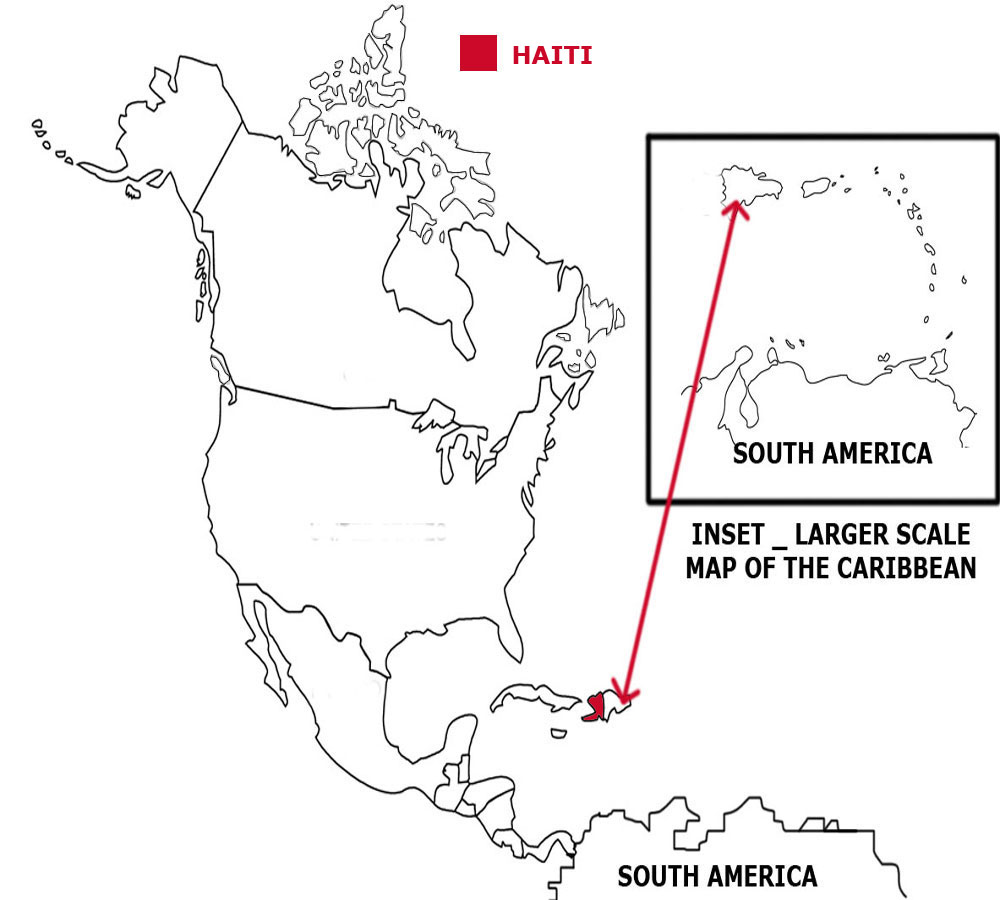

Check the weather in Port-au-Prince now.
This is the time in Port-au-Prince now
 The Haitian flag is 2 equal horizontal
stripes of blue, at the top, and red. A white rectangle in the centre of the flag bears the Haitian coat of arms. The coat of arms is a palm tree flanked by
flags and 2 cannon. Below this is a scroll saying L'union Fait La Force, which means Union is Strength.
The Haitian flag is 2 equal horizontal
stripes of blue, at the top, and red. A white rectangle in the centre of the flag bears the Haitian coat of arms. The coat of arms is a palm tree flanked by
flags and 2 cannon. Below this is a scroll saying L'union Fait La Force, which means Union is Strength.
Haiti is a presidential republic with a president as head of state and head of government.
In elections everyone over the age of 18 can vote.
The currency in Haiti is the gourde.
French and Creole are the official languages.
Hear the National Anthem
These are the anthem words
We have already written our own history of England but are asking schools in Haiti to provide us with a detailed history of
their own country. Check how here.
![]()
![]() Back to the top
Back to the top

The total land area of Haiti is 27,560 sq kms which is the 11th largest in North America.
Haiti has lakes, rivers and canals which total 190 sq kms.
Haiti has boundaries with 1 country
- Dominican Republic 376 kms
Haiti has a coastline of 1,771 kms which is the 7th longest in North America.
The highest point in Haiti is Chaine de la Selle at 2,680 metres.
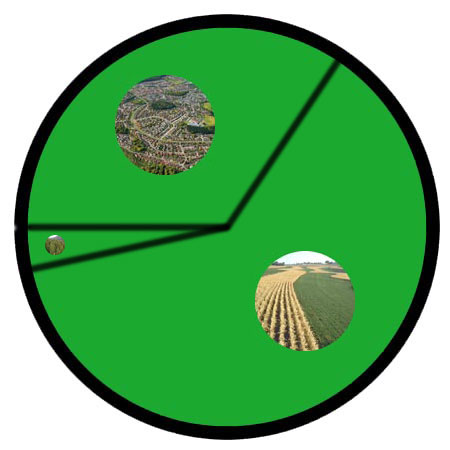

The total population of Haiti is 10.49 million people, making it the 7th largest country in North America by population.
Of this number 5.30 million are females and 5.19 million are males.
A person from Haiti is called a Haitian.
To be a citizen of Haiti, one of your parents must be a native-born citizen of Haiti. It is not sufficient to be born in Haiti. You have to live in Haiti for
5 years before you can begin to apply for citizenship.
The largest five cities in Haiti, by population are:-
- Port-au-Prince 1,234,742 people
- Delmas 382,920
- Petionville 283,052
- Port-de-Paix 250,000
- Croix-des-Bouquets 229,127
 Each little Owlbut is 1 person and
the big yellow rectangle is 1 sq km. After a while you can compare countries and see which ones are the most crowded. Remember it is only an average as
more people live closer together in towns and cities than in villages out in the country.
Each little Owlbut is 1 person and
the big yellow rectangle is 1 sq km. After a while you can compare countries and see which ones are the most crowded. Remember it is only an average as
more people live closer together in towns and cities than in villages out in the country.
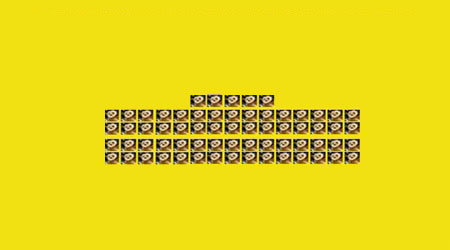
58.6% of the people live in cities or towns.

The birth rate in Haiti is 23.3 births per 1,000 of population
The death rate in Haiti is 7.7 deaths per 1,000 people.
Check this against the birth rate. If the death rate is higher than the birth rate then
the population will decrease unless immigrants arrive in the country.
There are 41.8 deaths of girls under 1 year per 1,000 of births and 54.6 deaths of boys.
The median age for females is 22.8 and for males is 22.4. The median age is that age which divides the population exactly in half so there are the same number
of people above the median age as below it.
The average age of a woman when she has her first child is 22.7.
The elderly dependency ratio is 7.5. This is the number of elderly people (ages 65+) per 100 people of working age (ages 15-64).
The potential support ratio is 13.3. This is the number of working-age people (ages 15-64) per one elderly person (ages 65+). As a population ages, the potential support ratio tends to fall, meaning there are fewer potential workers to support the elderly.
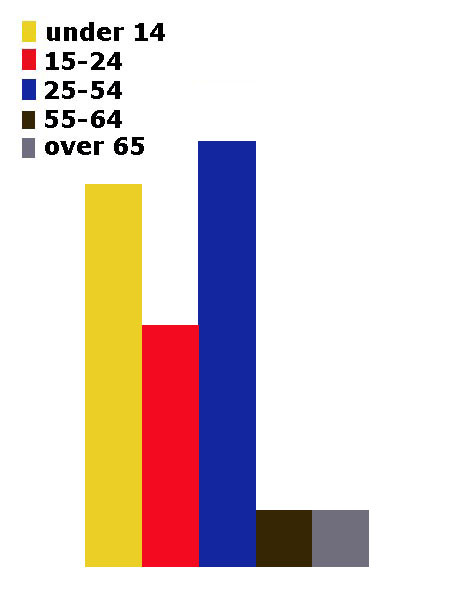
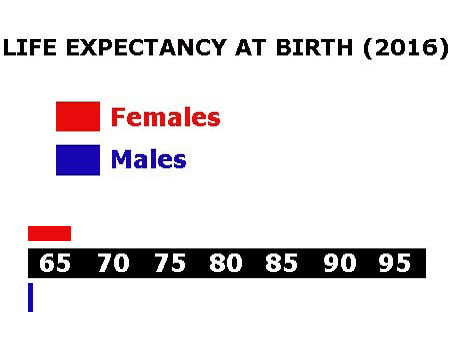

Haiti spends 7.6% of its total income on health care.
We have no figures for the number of doctors per 1,000 people.
There are 1.3 hospital beds per 1,000 people.
22.7% of the population are estimated as obese.
64.9% of the urban population and 47.6% of the rural population have drinking water that is either piped into their home or they have access to a public tap, a protected borehole, well, spring or
protected rainwater collection facility.
33.6% of the urban population and 19.2% of the rural population have access to a flushing toilet that is connected to a sewer. a pit latrine (that is a
permanent hole in the ground that is looked after) or a composting toilet.
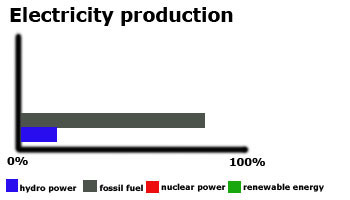
Haiti releases 2.1 million metric tons of carbon dioxide by burning fossil fuels in the process of producing and consuming energy. This puts it as the 16th highest in North America.

We have no figures for the amount Haiti spends on education.
The education system in Haiti was badly affected by the 2010 earthquake and is also undergoing some changes. At the moment, children usually start school
at age 5 in Haiti. Primary education is for six years until age 11 and compulsory secondary education must continue till 14 but can continue for a further 3 years.
This may be followed by further education at a university or college but at present only 1% of all pupils enrol for this.
Generally the school year consists of 3 terms and starts in the first week of September and finishes at the end of June. There is usually a 2 week
break at Christmas and a 1 week break at Easter.
57.3% of femals and 64.3% of males are able to read and write by the age of 15.
We have no figures for the number of people aged between 16 and 24 who are not in work. Among females 14.6% are unemployed while with males 19.5% can't find work.
The total number of people available for work in Haiti is 4.59 million.
 They work in the following sectors.
They work in the following sectors.
- Agriculture includes farming, fishing and forestry work
- Industry includes mining, manufacturing, construction and energy workers
- Services is everything else

There are 4 paved airports in Haiti, which is the 16th highest number in North America.
![]()
There are no railways in Haiti.
![]()
There are 768 kilometres of roads in Haiti, which means Haiti is in 17th place for the most kilometres of roads in North America.
![]()
There are 2 major national newspapers in Haiti.
There are 7.41 million mobile phone users.
Under 1% of the people have a fixed landline.

1.23 million people have access to the internet at home via any device (computer or mobile).


